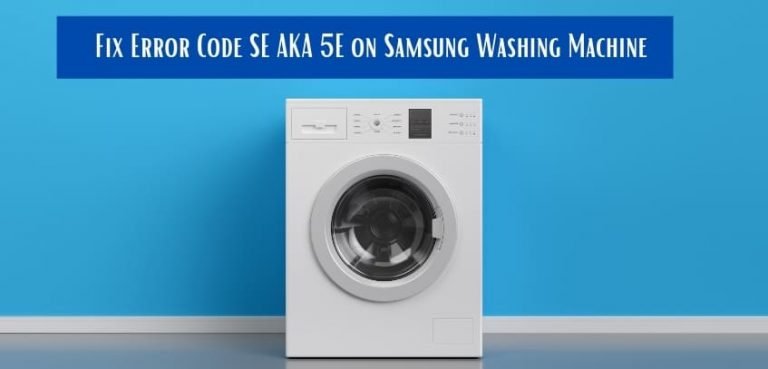
Imagine you’re ready to tackle a mountain of laundry, but your washing machine suddenly stops and flashes the “SE” error. It’s like your car’s check engine light suddenly illuminating—you know it means something needs attention, but you’re not sure what to do next. The SE error code in Samsung washing machines is essentially a signal sent by your washer to indicate it’s having trouble draining water. This can happen for several reasons, and while it may sound technical, fixing it could just be a matter of a few straightforward steps.
Understanding the Samsung SE Error Code
Before diving into solutions, let’s get to the bottom of what the SE error code actually represents. To put it simply, this code generally relates to a drainage issue. Imagine your washing machine as a mini ecosystem that needs to cycle water in and out smoothly to function properly. If something interrupts this flow—be it a blocked pipe, clogged filter, or a faulty drain pump—the machine will let you know by displaying the SE error.
When water can’t exit the washer as expected, it’s like trying to empty a bathtub with a blocked drain. The machine will pause its cycle until the problem is resolved, as it simply can’t continue without the water being drained. This safeguard is important to prevent waterlogged laundry and potential flooding. You might notice water sitting in the drum when you attempt to open the door—another clear sign that the machine is not draining as it should.
The “SE” code is not exclusive to Samsung; it echoes the same concerns in other washing machine brands, albeit under different labels like “5E” or similar. This focus on proper drainage is a universal consideration across washers, showcasing the importance of maintaining an efficient water cycle within these appliances.
Common Causes of the SE Error Code
Now, you might be wondering what could cause such a disruption in your washing machine’s drainage system. One surprisingly common culprit is a blocked drain hose. Think of the drain hose as the machine’s exit pathway for water. If it’s kinked, twisted, or obstructed by debris, water can’t flow through easily, leading to that SE error popping up. Checking for visible blockages or improper hose positioning can sometimes solve the issue right away.
Another potential cause could be a clogged pump filter. Much like how a coffee filter needs to be clear for your morning brew to flow smoothly, the washing machine requires its pump filter to be unobstructed for water to pass through effectively. Over time, lint, small clothing items, or even coins can sneak through and clog the filter. Cleaning out these filters is crucial and something that should be done regularly to maintain machine efficiency.
Lastly, there might be an issue with the drain pump itself. If the pump is malfunctioning or has worn out, it might not be able to push the water out of the machine as designed. Think of the pump as the heart of the drainage process—if it’s not pumping well, nothing flows. In this case, professional repair or replacement might be required, but diagnosing this at home can save a lot of guesswork for a repair technician.
Steps to Fix the SE Error
So, how do you go about fixing this pesky SE error? Here’s the deal: you can often solve it by following a systematic approach. Start by powering off the machine and disconnecting it from the power supply—safety first! Then, take a look at the drain hose. Ensure it’s not kinked and inspect it for any visible clogs. Adjust the hose as needed and ensure it has a smooth path to the drain outlet.
Next, locate and clean out the pump filter. This might sound daunting, but it’s typically an easy process—akin to cleaning out a vacuum cleaner filter. First, make sure the machine is off and locate the filter access panel, usually found at the front bottom of the washer. Opening this panel might require a screwdriver. Once opened, prepare for a bit of water spillage and remove the filter cap. Clean out any debris, rinse it if necessary, and replace it securely.
If these steps don’t resolve the issue, the problem might lie within the drain pump itself. At this point, if you’re not comfortable with investigating further, it may be time to call in a professional. A certified technician will have the right tools and expertise to handle more complex repairs without risking further damage to your washing machine.
Preventing Future SE Errors
Nobody wants to encounter the SE error repeatedly. Thankfully, there are proactive measures you can take to prevent this from becoming a recurring issue. Regular maintenance can make a world of difference. For instance, make it a habit to check and clean the pump filter every month or so. This small task can prevent major clogs and extend the life of your machine.
Additionally, be mindful of what goes into your washer. Loose coins, tissues, or excessively dirty items can contribute to blockages. It’s a bit like being cautious about what you put down your kitchen sink to avoid a plumbing nightmare. Sorting through clothing pockets and shaking off excess dirt before loading your washer can help avoid unnecessary buildups.
Finally, ensure that the drain hose is free from kinks and positioned correctly after each use. By keeping these aspects in check, you’re allowing your washing machine to operate smoothly, reducing the chance of an SE error flashing again.
In conclusion, while the Samsung washing machine SE error might initially cause some worry, understanding its meaning and knowing how to address it can eliminate stress and restore your laundry routine. With some basic troubleshooting and preventative care, you’ll keep your washing machine running efficiently and avoid those unexpected interruptions.